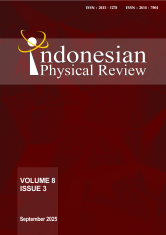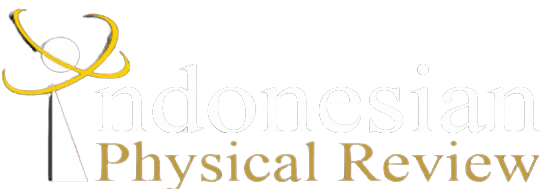SYNTHESIS OF SINGLE-PHASE HYDROXYAPATITE POWDER FROM EGGSHELL WASTE VIA CO-PRECIPITATION METHOD AND ITS STRUCTURAL CHARACTERIZATION
DOI:
10.29303/ipr.v8i3.451Downloads
Abstract
This study aims to synthesize a single-phase hydroxyapatite powder using waste chicken eggshells as a calcium source via the co-precipitation method. The process focuses on optimizing calcination time and temperature to achieve high-purity hydroxyapatite. The co-precipitation procedure involved controlled pH adjustment and aging time, contributing to the formation of homogeneous particles. Chicken eggshells, predominantly composed of calcium carbonate (CaCO3), were calcined at 1000°C for 15 hours to produce calcium oxide (CaO). The resulting CaO was then reacted with phosphate ions in an aqueous solution, followed by a calcination at 900°C for varying holding times of 5 and 10 hours. X-ray diffraction (XRD), Fourier-transform infrared spectroscopy (FTIR), and Brunauer-Emmett-Teller (BET) analysis were conducted to evaluate phase composition, crystal size, and texture properties. The optimum condition was found at 900 °C for 10 h calcination, resulting in single-phase hydroxyapatite, a crystallite size of 220 nm, an average pore radius of 6.78 nm, a total pore volume of 0.02 cc/g, a surface area of 6.38 m2/g, and an average particle radius of 213.89 nm. These findings highlight the potential of this method for producing bioceramics with desirable properties for use in bone grafts and other biomedical materials.
Keywords:
Hydroxyapatite Calcination Biowaste Structural property Single-phaseReferences
A. Singh, K. Kumari, and P. P. Kundu, “Synthesis of Biomimetic Hydroxyapatite from Natural Sources for Bone Tissue Engineering,†in Encyclopedia of Green Materials, C. Baskar, S. Ramakrishna, and A. Daniela La Rosa, Eds., Singapore: Springer Nature, 2022, pp. 1–14.
Y. Oshida and T. Miyazaki, Bone-Grafting Biomaterials: Autografts, Hydroxyapatite, Calcium-Phosphates, and Biocomposites. Walter de Gruyter GmbH & Co KG, 2024.
D. G. Filip, V.-A. Surdu, A. V. Paduraru, and E. Andronescu, “Current Development in Biomaterials—Hydroxyapatite and Bioglass for Applications in Biomedical Field: A Review,†J. Funct. Biomater., vol. 13, no. 4, Art. no. 4, Dec. 2022.
M. Waheed, M. Yousaf, A. Shehzad, M. I. U. Raheem, M.K. I. K. Khan, M. R. Khan , N. Ahmad, Abdullah, and R. M. Aadil, “Channelling eggshell waste to valuable and utilizable products: A comprehensive review,†Trends in Food Science & Technology, vol. 106, pp. 78–90, Dec. 2020.
Y. Zhang, H. M. Pham, and S. D. Tran, “The Chicken Egg: An Advanced Material for Tissue Engineering,†Biomolecules, vol. 14, no. 4, Art. no. 4, Apr. 2024.
A. Szcześ, L. Hołysz, and E. Chibowski, “Synthesis of hydroxyapatite for biomedical applications,†Adv. Colloid Interface Sci., vol. 249, pp. 321–330, Nov. 2017.
N. A. S. Mohd Pu’ad, R. H. Abdul Haq, H. Mohd Noh, H. Z. Abdullah, M. I. Idris, and T. C. Lee, “Synthesis method of hydroxyapatite: A review,†Mater. Today Proc., vol. 29, pp. 233–239, Jan. 2020.
P. Arokiasamy, M. M. A. B. Abdullah, S. Z. A. Rahim S. Luhar, A. V. Sandu, N. H. Jamil, and M. Nabiałek, “Synthesis methods of hydroxyapatite from natural sources: A review,†Ceramics International, vol. 48, no. 11, pp. 14959–14979, Jun. 2022.
V. G. DileepKumar, M. S. Sridhar, P. Aramwit, V. K. Krut'ko, O. N. Musskaya, I. E. Glazov, and N. Reddy, “A review on the synthesis and properties of hydroxyapatite for biomedical applications,†Journal of Biomaterials Science, Polymer Edition, vol. 33, no. 2, pp. 229–261, Jan. 2022.
P. O. Etinosa, O. A. Osuchukwu, E. O. Anisiji, M. Y. Lawal, S. A. Mohammed, O. I. Ibitoye, P. G Oni, V. D. Aderibigbe, T. Aina, D. Oyebode, and S. C. Nwigbo, “In-depth review of synthesis of hydroxyapatite biomaterials from natural resources and chemical regents for biomedical applications,†Arabian Journal of Chemistry, vol. 17, no. 12, p. 106010, Dec. 2024.
B. Prayitno, M. Musyarofah, G. U. N. Tajalla, A. R. Nafisah, S. Norhidayah, and S. A. Kartika, “The effect of calcination temperature and holding time on structural properties of calcia powders derived from eggshell wastE,†Indonesian Physical Review, vol. 8, no. 1, pp. 281–299, Jan. 2025.
M. Musyarofah, Y. P. Sari, A. R. Hilmi, M. Z. Asrori, Triwikantoro, M. Zainuri, B. N. Kim and S. Pratapa, “Ultra-dense (Bi, V, B)-oxide-added zircon ceramics fabricated by liquid-phase assisted spark plasma sintering (SPS),†Mater. Res. Express, vol. 10, no. 5, p. 055002, May 2023.
Musyarofah, E. F. Damanik, A. R. Septiana, D. M. Shoodiqin, Husain, and G. Yudoyono, “Phase study of Mg1-xZnxTiO3 powders prepared by dissolved metals mixing method,†AIP Conf. Proc., vol. 2652, no. 1, p. 050013, Nov. 2022.
H. Faridi and A. Arabhosseini, “Application of eggshell wastes as valuable and utilizable products: A review,†Res. Agric. Eng., vol. 64, no. 2, pp. 104–114, Jun. 2018.
J. M. Valverde, P. E. Sanchez-Jimenez, and L. A. Perez-Maqueda, “Limestone Calcination Nearby Equilibrium: Kinetics, CaO Crystal Structure, Sintering and Reactivity,†J. Phys. Chem. C, vol. 119, no. 4, pp. 1623–1641, Jan. 2015.
Z. Li, X. Guo, X. Xue, X. Xu, and B. Wang, “Investigations on Kinetics and Mechanisms of CaCO3 Calcination in Calcium Looping,†Ind. Eng. Chem. Res., vol. 62, no. 12, pp. 4851–4863, Mar. 2023.
M. Silakhori, M. Jafarian, A. Chinnici, W. Saw, M. Venkataraman, W. Lipiński, and G. J. Nathan, “Effects of steam on the kinetics of calcium carbonate calcination,†Chem. Eng. Sci., vol. 246, p. 116987, Dec. 2021.
B. C. Smith, Infrared Spectral Interpretation: A Systematic Approach. Boca Raton: CRC Press, 2018.
A. Mittal, M. Teotia, R. K. Soni, and J. Mittal, “Applications of egg shell and egg shell membrane as adsorbents: A review,†J. Mol. Liq., vol. 223, pp. 376–387, Nov. 2016.
M. S. Hossain, M. A. A. Shaikh, and S. Ahmed, “Synthesis of gypsum fertilizer from waste eggshells for a sustainable environment,†Mater. Adv., vol. 4, no. 1, pp. 240–247, Jan. 2023.
R. Sumang and P. Panpho, “Investigating the potential of waste oyster shell as a sustainable bio-mordant in natural dyeing,†Sci. Rep., vol. 14, no. 1, p. 25509, Oct. 2024.
M. Khalid, S. S. Jikan, S. Adzila, Z. M. Yunus, and N. A. Badarulzaman, “Characterizations of Calcium Oxide from Calcined Eggshell Waste,†Key Eng. Mater., vol. 908, pp. 130–134, 2022.
N. Suwannasingha, A. Kantavong, S. Tunkijjanukij, C. Aenglong, H.-B. Liu, and W. Klaypradit, “Effect of calcination temperature on structure and characteristics of calcium oxide powder derived from marine shell waste,†J. Saudi Chem. Soc., vol. 26, no. 2, p. 101441, Mar. 2022.
N. Tangboriboon, R. Kunanuruksapong, and A. Sirivat, “Preparation and properties of calcium oxide from eggshells via calcination,†Mater. Sci.-Pol., vol. 30, no. 4, pp. 313–322, Dec. 2012.
R. H. Borgwardt, “Sintering of nascent calcium oxide,†Chem. Eng. Sci., vol. 44, no. 1, pp. 53–60, Jan. 1989.
H. R. Javadinejad and R. E. Kahrizsangi, “Thermal and kinetic study of hydroxyapatite formation by solid-state reaction,†International Journal of Chemical Kinetics, vol. 53, no. 5, pp. 583–595, May 2021.
D. Fitriyana, R. Ismail, A. Bayuseno, J. Siregar, and T. Cionita, “Characterization of Hydroxyapatite Extracted from Crab Shell Using the Hydrothermal Method with Varying Holding Times,†J. Renew. Mater., vol. 12, no. 6, pp. 1145–1163, 2024.
J. Zhao and M. P. Harmer, “Effect of Pore Distribution on Microstructure Development: II, First- and Second-Generation Pores,†J. Am. Ceram. Soc., vol. 71, no. 7, pp. 530–539, 1988.
S. Jaenicke, G. K. Chuah, V. Raju, and Y. T. Nie, “Structural and Morphological Control in the Preparation of High Surface Area Zirconia,†Catal. Surv. Asia, vol. 12, no. 3, pp. 153–169, Sep. 2008.
J. Jeong, J. H. Kim, J. H. Shim, N. S. Hwang, and C. Y. Heo, “Bioactive calcium phosphate materials and applications in bone regeneration,†Biomater Res, vol. 23, p. 4, 2019.
E. Fiume, G. Magnaterra, A. Rahdar, E. Verné, and F. Baino, “Hydroxyapatite for Biomedical Applications: A Short Overview,†Ceramics, vol. 4, no. 4, Art. no. 4, Dec. 2021.
R. Nurlaila, Musyarofah, N. F. Muwwaqor, Triwikantoro, A. Kuswoyo, and S. Pratapa, “Phase analysis of ZrO2-SiO2 systems synthesized through Ball milling mechanical activations,†AIP Conf. Proc., vol. 1788, no. 1, p. 030122, Jan. 2017.
Z. Alhalili and M. Smiri, “The Influence of the Calcination Time on Synthesis of Nanomaterials with Small Size, High Crystalline Nature and Photocatalytic Activity in the TiO2 Nanoparticles Calcined at 500 °C,†Crystals, vol. 12, no. 11, Art. no. 11, Nov. 2022.
License

This work is licensed under a Creative Commons Attribution-NonCommercial-ShareAlike 4.0 International License.
Authors who publish with Indonesian Physical Review Journal, agree to the following terms:
- Authors retain copyright and grant the journal right of first publication with the work simultaneously licensed under a Creative Commons Attribution-ShareAlike 4.0 International Licence (CC BY SA-4.0). This license allows authors to use all articles, data sets, graphics, and appendices in data mining applications, search engines, web sites, blogs, and other platforms by providing an appropriate reference. The journal allows the author(s) to hold the copyright without restrictions and will retain publishing rights without restrictions.
- Authors are able to enter into separate, additional contractual arrangements for the non-exclusive distribution of the journal's published version of the work (e.g., post it to an institutional repository or publish it in a book), with an acknowledgment of its initial publication in Indonesian Physical Review Journal.
- Authors are permitted and encouraged to post their work online (e.g., in institutional repositories or on their website) prior to and during the submission process, as it can lead to productive exchanges, as well as earlier and greater citation of published work (See The Effect of Open Access).





